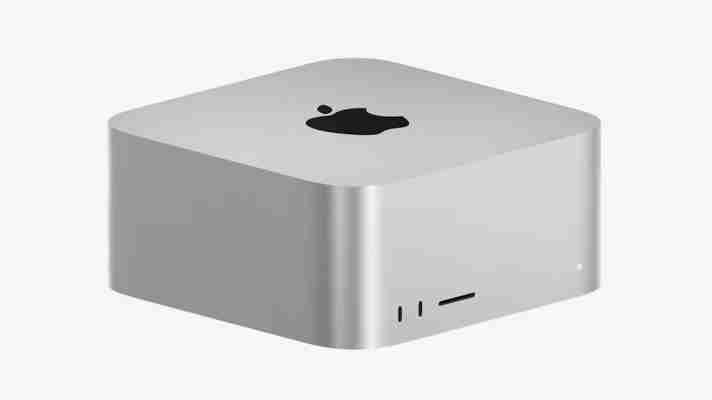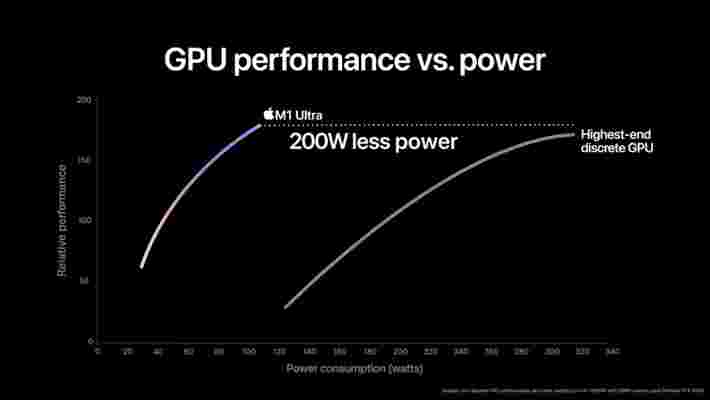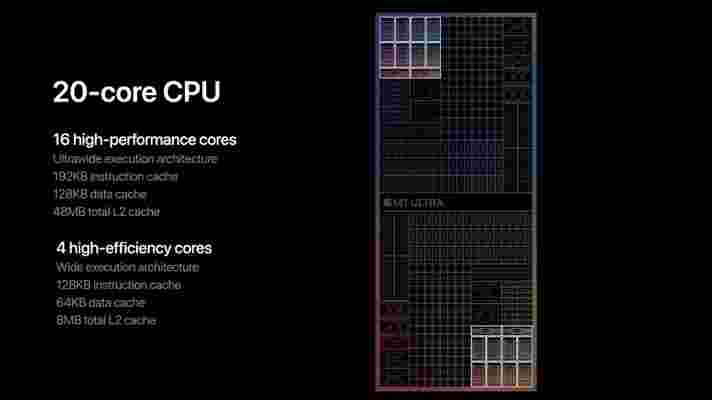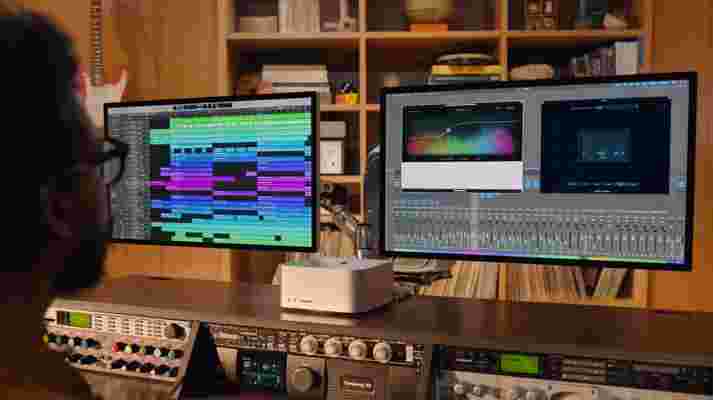6 things you might have missed about the Apple Event
Well, wasn't that interesting? This year's Apple Spring Event was speedier than usual, so we only heard the word "incredible" about 200 times instead of the usual thousands.
And no wonder, because there was lots to cover: the new iPhone SE 2022 , the iPad Air 2022 , the M1 Ultra system on a chip, the Mac Studio and the Studio Display .
In fact, there was so much going on that you might have missed a few interesting details. How many of these did you spot?
1. A non-announcement announcement of the Mac Pro
"That's for another day." And that's as much as Apple was ready to say about the next Mac Pro during its March 8 event.
But given that the Mac Studio outperforms Apple's Pro Macs in quite spectacular fashion, imagine how many M1 processors Apple is currently sellotaping together for the next Mac Pro – and how much it's going to cost. Better start saving…
2. The Studio Display doesn't have Face ID

The camera in the new Studio Display is good enough for Center Stage, which it brings to the Mac for the first time, but it doesn't have the sensors for Face ID.
3. Apple's cheapest iPhone just went up in price
So much for the rumors that the current iPhone SE would get a price cut and the iPhone SE 2022 would be as cheap as chips.
Instead, Apple canned the existing model and added thirty bucks to the price tag of the new one. We knew the rumor was likely to be wishful thinking but it would have been nice if that one had come true.
4. The Mac Studio doesn't come with a keyboard

Or a mouse. You'd think a four grand computer might manage to include an input device, wouldn't you?
The original Mac mini didn't, but that was to keep the price down; this costs quite a bit more. We bet when the Apple Car finally ships, the wheels will be an optional extra.
5. The 'toughest glass' isn't Apple's toughest
The iPhone SE 2022 may well have "the toughest glass of any smartphone", but the iPhone 12 and 13 don't technically have normal glass: they have Ceramic Shield, which is tougher.
6. A subtle nod to IWD
The Apple Event happened to coincide with International Women's Day, and Apple marked it in a subtle and classy way by giving women the mic for the majority of its presentation.
We heard from Francesca Sweet for the iPhone, Angelina Kyazike for the iPad, Colleen Novielli for the Mac Studio and Nicole Kordes for the Studio Display. And all the developers featured in the M1 Ultra segment were women too.
LG's 2022 OLED TVs are finally on sale in the UK and US, and there are already deals
The wait is finally over: most of LG’s 2022 OLED TVs are available to buy in the US and UK.
If you head over to your retailer of choice you should start to see LG’s new B2 OLED, C2 OLED , and G2 OLED screens appear on their physical and virtual store shelves. Unfortunately, those of you with your eyes on the A2 OLED or Z2 OLED will have to wait a little longer (via WhatHiFi ).
For those of you in the US, the best place to head is either Amazon or Walmart, though if you’re lucky you might be able to snatch up a quick deal if you head to the latter.
That’s because Walmart currently has the 55-inch G2 OLED on sale for just $1,780 . That’s $117 cheaper than an LG C2 OLED of the same size, and $416 less than what the LG G2 should cost.
Given that it's the only deal on these new TVs that Walmart's running, and that the page doesn't include any signs that this is a deal this is likely an error on Walmart’s part. As such expect this offer to vanish fairly swiftly once it's noticed.

Meanwhile, if you’re in the UK, the best deal we can find right now is at John Lewis. For starters you’ll be able to participate in LG’s cashback promotion ; up until July 31, you can claim back up to £300 depending on the model you buy.
On top of that John Lewis is currently giving new and current My John Lewis members a £100 E-Gift Card when they buy a new 2022 LG OLED TV (with the offer extending to other electronics as well ). You could then spend this on almost anything at John Lewis including a new soundbar or something else to further enhance your home cinema setup.
If you're after LG's 55-inch C2 OLED (priced at £1,899) then these deals will effectively score you a £300 saving. That's pretty good for an out-of- Black Friday deal .
Analysis: LG's 2022 TVs are its best yet
We've had the chance to test out the new LG G2 OLED and LG C2 OLED TVs, and both earned five stars in their respective reviews.
The cheaper LG C2 TV wowed us with its vivid colors and high contrast images delivered by its new OLED Evo panel tech (only available on the 55-inch model and larger).
Its other incremental improvements over the LG C1 OLED , while less showy, still impressed us and made the C2 feel like a worthy successor to 2021's best TV . The only downside was that its virtual surround sound wasn't quite as convincing as we would have liked.
The more expensive LG G2 OLED also blew us away thanks to its new OLED Evo panel design. The new heat sink element not present in 2021’s G1 series TV allowed the G2 to bring new levels of brightness and take OLED beyond where we thought it could go.
You'll have to make sure you have space to hand this TV on your wall though, as a regular TV stand for the LG G2 TV costs extra.
Apple M1 Ultra is here - everything you need to know about Apple's powerhouse
Apple has announced an all-new high-end CPU at its March 2022 hardware even t, the M1 Ultra. This processor's aim is to bring higher performance, likely to desktop PCs meant for creative professionals.
Apple claims that this is the biggest processor ever built, a feat it was able to accomplish by taking two M1 Max dies and bridging them with a connector, which allows Apple to reach incredible performance without losing efficiency as the two chips are basically talking to each other.
The massive M1 Ultra chip has a GPU with 8,192 execution units, which would place it on the same level as an RTX 3080 from paper specs alone. We'll have to wait and see how it plays out in our tests, though.
Just like the rest of the M1 family of processors, the M1 Max is a system-on-a-chip design, which means the CPU, GPU, RAM, storage and media engine are all included in one big chip.
Unlike Apple's other SoC's, though, the M1 Ultra will only be available in the Mac Studio. An M1 Ultra-powered Mac Studio will start at $3,999 in the US, £3,999 in the UK, and AU$6,099 in Australia. It's available on March 18.

Better than an RTX 3090? We'll see
Among all the numbers Apple showed in the reveal for the M1 Ultra was a chart saying that the M1 Ultra could reach higher levels of performance as a system than an Nvidia GeForce RTX 3090 and an Intel Core i9-12900K, while consuming 200W less power.
It's a bold claim, but one we could see Apple actually delivering on, depending on how much power it's willing to pump into its desktop-class components. The M1 Ultra has a 64-core discrete-class GPU with 8,192 execution units. These have a different name, but would essentially be a similar concept to CUDA cores for Nvidia or Streaming Multiprocessors for AMD graphics cards.
With 8,192 EUs, that's right up there with the Nvidia GeForce RTX 3080 and AMD Radeon RX 6800 XT, so we wouldn't be surprised if the more efficient 5nm manufacturing process would be able to deliver even more performance on the same amount of compute units.

Specs to back it up
The GPU built into the M1 Ultra, with its 64 cores, is the big story of Apple's March 2022 event, to be sure, but the actual CPU is nothing to scoff at. With the M1 Ultra, you get a 20-core CPU with 114 billion transistors, making it one of the most dense processors ever built for a consumer-class device.
Those cores break down into 16 high-performance cores and 4 efficiency-cores. If you're unfamiliar, this follows the same kind of hybrid chip design as the M1 did. The high-performance cores are there to handle heavy workloads that need as much brute force as possible, and the high-efficiency cores work in the background to take care of background tasks as they appear.
The M1 Ultra, comparatively speaking, has many more performance cores for each efficiency core than the original M1 chip that appeared in 2020. Apple's first computing chip split its 8 cores down the middle, with 4 performance cores and 4 efficiency cores. That allowed the MacBook Air and 13-inch MacBook Pro to easily balance performance and battery life.
However, because the M1 Ultra is only in the Mac Studio, battery life isn't a concern. Apple can prioritize loading the chip with high-performance cores without adding more efficiency cores, because it simply doesn't need to take battery life into the equation. For the creative professionals that will be using the M1 Ultra, power is the name of the game.
This is also the Mac chip that will support up to 128GB of RAM, so it's clearly meant to power creative-class workloads like video editing and rendering, which demand huge amounts of RAM. That might sound like a lot of memory, but if you need that much RAM, you need it, and there's never going to be enough.
Apple was able to achieve this by smooshing two M1 Max dies together and bridging them via an interconnect, lovingly called UltraFusion. Apple claims that this has twice the connection density of any technology - again, we'll see - but it means that there's 2.5TB/s of bandwidth between the two main CPU chiplets, which should essentially eliminate lag between them, or make it so minimal that it's meaningless.
Apple also included a graph showing the raw CPU performance of the M1 Ultra against the Intel Core i9-12900K, which has a similarly-built CPU. Apple is claiming that it can double the Core i9-12900K's performance with much less power. That'd be incredible if it's true, as in our testing, the Intel Core i9-12900K is easily the most powerful mainstream desktop processor on the market right now. We just wonder how they compare to the new AMD Ryzen Threadripper Pro CPUs .

Studio fresh
If you're a creative professional that wants to harness the raw power of the M1 Ultra, you're going to be looking at the Mac Studio. It looks like a Mac mini but bigger, and is able to power this monster of a processor in a chassis that's just 3.7 inches thick and 7.7 inches long. That's just a little bit thicker than the Mac mini, and should keep your desk clear.
With the Mac Studio, which starts at $3,999 / £3,999 / AU$6,099 if you want an M1 Ultra-powered version, Apple is claiming that it'll feature 90% faster than an entry-level Xeon Mac Pro, and a GPU that is essentially 3 Radeon Pro 5700 XTs. All of that integrated into a single chip.
That's the only Mac with the new M1 Ultra processor, but that's not too terribly surprising. The amount of power that something like this would require is just too much for a mobile form factor, so it's unlikely that we'll ever see the M1 Ultra make its way into something like the MacBook Pro - at least not in its current iteration.
But, even though it's expensive with the M1 Ultra, it's still much more accessible than the Mac Pro. Though, to be clear, the M1 Ultra is only really going to be necessary for creative professionals that need an extremely fast processor to make their living. And, as such, the Mac Studio should be considered a professional-level device. Both of these things make the $3,999 price tag even more impressive, even though, yeah, you could get an equivalent Windows 11 desktop for less cash.
Leaked benchmarks
Only a few hours after the M1 Ultra was officially revealed, benchmark scores were seemingly leaked onto the internet, and the results look very promising.
As MacRumors reports , the 20-core M1 Ultra has been spotted in Geekbench 5 scores, achieving a single-core score of 1,793 and a multi-core score of 24,055.
This is impressively high, with the high end Mac Pro in its most expensive configuration, with a 28-core Intel Xeon W chip, scoring 1,152 and 19,951 in the same tests.
This means the M1 Ultra is 21% faster in multi-core performance, and 56% faster in single-core performance, and impressive feat considering the core advantage the Intel Xeon chip has.